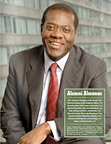Debating New York’s Judicial Elections
Lawyers argue the finer points of how the state chooses trial judges to run for the bench.
Printer Friendly VersionNew York has a unique system of nominating its candidates for state trial court: Political parties hold behind-closed-doors conventions to select who runs in judicial elections. This contrasts with the process for other courts in the Empire State, such as city court, family court and surrogate court, where nominees are selected through primary elections. The convention system’s constitutionality was at the center of López-Torres v. New York State Board of Elections, a case that made its way to the Supreme Court in October 2007.
Before the Court handed down its verdict, a panel including lawyers from both sides of the case and faculty experts in election law analyzed New York’s convention process and debated the value of judicial elections, during the NYU Law Alumni Association’s annual fall lecture, “Are New York Judicial Elections in Crisis?”
 Moderator Samuel Issacharoff, Bonnie and Richard Reiss Professor of Constitutional Law, provided background. Surrogate Judge Margarita López-Torres first sued the New York State Board of Elections in 2004 after she claimed that her refusal to hire the daughter of a prominent Democrat as a clerk led to the denial of her nomination to run for a spot on the State Supreme Court. The suit alleged that the closed convention process allowed the spurned party boss to give the nod to another judge. Issacharoff pointed out the inherent constitutional difficulty in deciding a case like López-Torres. “We pride ourselves on being a democracy and living under a constitutional order,” he said, “but our constitution says very little about the greater future of our democracy, which is how people get elected.”
Moderator Samuel Issacharoff, Bonnie and Richard Reiss Professor of Constitutional Law, provided background. Surrogate Judge Margarita López-Torres first sued the New York State Board of Elections in 2004 after she claimed that her refusal to hire the daughter of a prominent Democrat as a clerk led to the denial of her nomination to run for a spot on the State Supreme Court. The suit alleged that the closed convention process allowed the spurned party boss to give the nod to another judge. Issacharoff pointed out the inherent constitutional difficulty in deciding a case like López-Torres. “We pride ourselves on being a democracy and living under a constitutional order,” he said, “but our constitution says very little about the greater future of our democracy, which is how people get elected.”
Richard Pildes, Sudler Family Professor of Constitutional Law, saw López-Torres as just one flare-up in the greater epidemic of troubling judicial elections. He suggested changing the event’s title to “Are Judicial Elections a Crisis?” calling them “a truly bad idea” and the worst American contribution to the design of government and law.
No other nation holds judicial elections, which lead some to wonder how a judge remains impartial while seeking contributions and political endorsements. Lawrence Mandelker ’68, an election-law expert and then-president of the NYU Law Alumni Association, discussed the pros and cons of elective versus appointive methods of judicial selection, noting that while López-Torres involves important constitutional issues concerning specific methods of nominating candidates, “it does not address the normative question of whether it’s a good idea for judges to be elected in the first place.”
In the basic argument of López-Torres, however, critics allege conventions violate the First Amendment by denying voters a direct choice in whom to nominate, and that they lack transparency and give political party leaders, not rank-and-file party members, the power to choose judicial candidates. It is the secrecy of these “smoke-filled rooms” that panelist Kent Yalowitz said promotes corruption and undue favoritism in judicial nominations. “Every district in New York, for every party, is controlled by one person,” said Yalowitz, who has represented López-Torres since 2004. “Party members who want to participate in the system get frozen out.”
But Caitlin Halligan, the former solicitor general for New York, argued that political parties have the right to opt for a closed convention nominating system. Andrew Rossman, counsel of record for the Manhattan Democratic Party in López-Torres, further explained that New York’s system was enacted by a 1921 law designed to stop judges from having to take campaign contributions during their primary and election campaigns. “[Lawmakers] didn’t do this in a vacuum,” Rossman said. “They did it after a nine-year experiment with primaries that proved to be a complete failure.”
Alas, the final word was not to be found in the Supreme Court decision in January 2008. By ruling unanimously that New York’s conventions are constitutional, the Court placed the responsibility on lawmakers in Albany to continue to determine New York’s system of judicial nominations.
—
